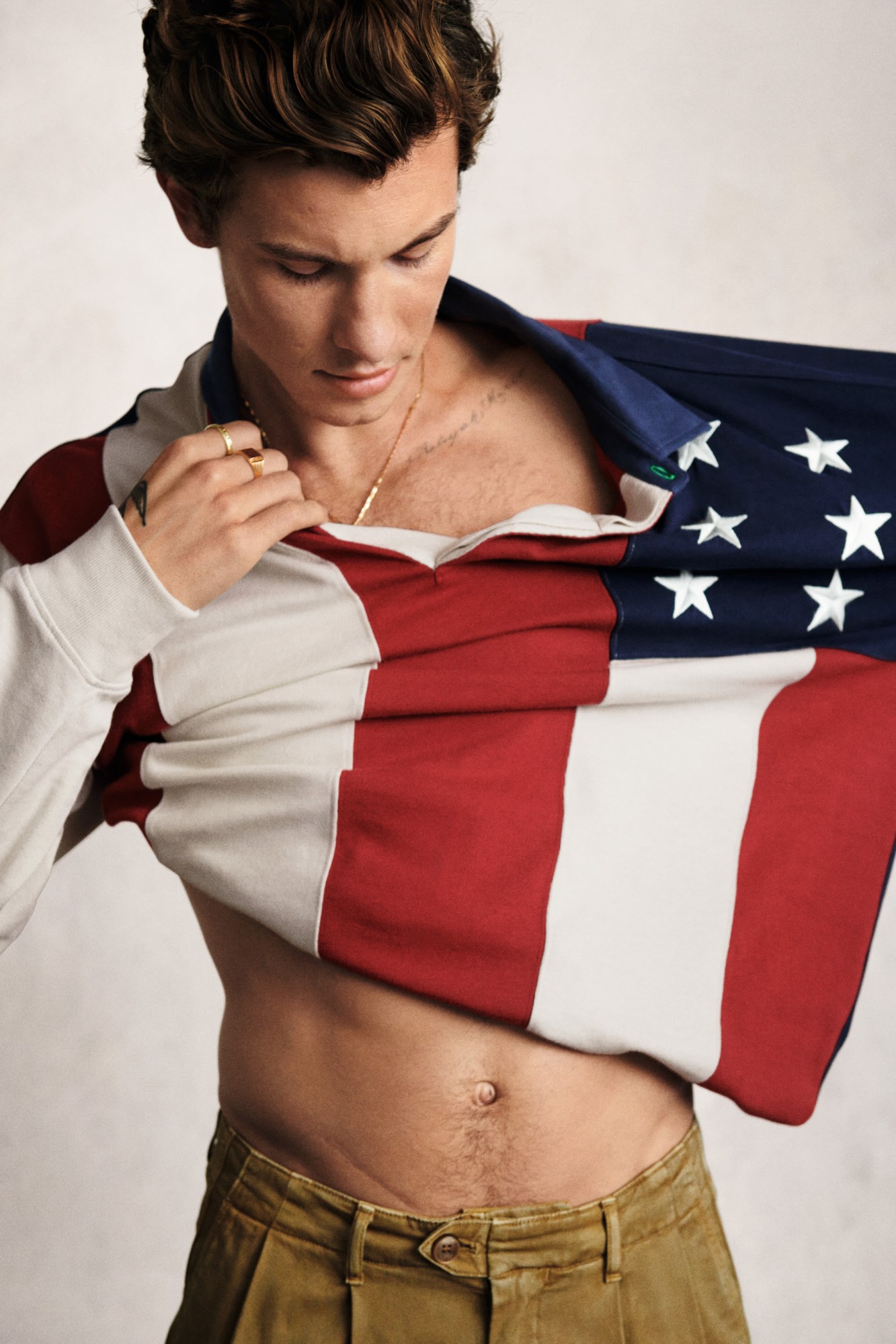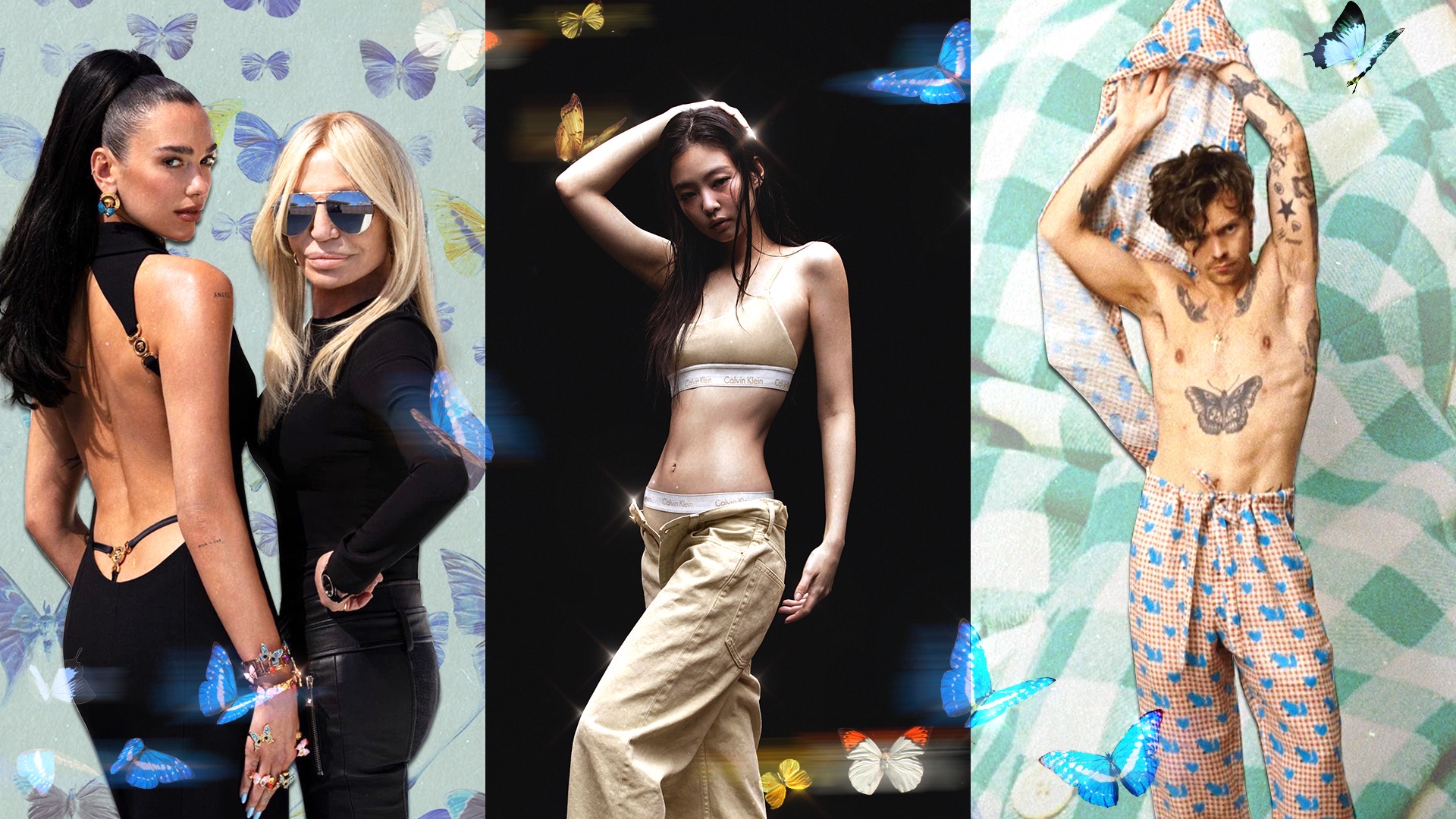“It’s Versace x Dua Lipa, not Versace x Forever 21” reads a comment by pop music stan @peachy_peachx on Twitter. Their post is in response to a TikTok furore over the pricing of Versace’s La Vacanza collection, a Cruise 2024 line of shimmering, Barbie-esque, Y2K-inspired pieces designed by both Donatella and Dua. While the runway show and the pieces, also seen in Dua’s latest music video, went viral on its launch, the Loves (as Dua’s fans are called) were not pleased.
“The Dua Lipa Versace prices are kooky crazy” is written over the screen of one TikTok as the fan scrolls through the £2,680 medusa dresses and £920 crystal butterfly sandals on the Versace e-shop, while a comment beneath the video laments that they “don’t get the target market, why do a collab with a very public star when it’s so out of price range for the public?” Obviously Versace aren’t going to be selling a crystal and glass butterfly covered mini skirt at high street prices on their site. But as the number of popstar designed luxury collections at major fashion houses increases, the question does remain, if these collections aren’t intended for the stans to snap up, then who, and what, are they for exactly?

Just months before Dua x Versace, we had Gucci HA HA HA, besties Harry Styles and Alessandro Michelle’s highly-anticipated line together. More recently Jennie of BLACKPINK launched her own capsule of pastel and neutral toned basics at Calvin Klein, while Shawn Mendes got together with Tommy Hilfiger on an American Sports-coded line. Then, after the 2018 Coachella performance hoodie (a bright cropped garment that was priced at over a grand) from the pair, Beyoncé served as both muse and collaborator on a one-of-a-kind couture collection from Olivier Rousteing at Balmain. These collections all align with the aesthetics of the house more so than that of the artist themselves which, as fashion commentator José Criales Unzueta tells us, makes sense given popstars tend to reinvent their image and style every album cycle. “It’s meant to be an exploration of a common aesthetic ground with motifs that work well with both the brand and the artist. That means no co-branded logos (other than in the labels) and no straightforward references to the artist and their work”, he adds.
While a collaboration with a popstar could be seen as a potentially lowbrow move, the price point, quality, and giant roll outs of many of these collections suggest the houses wish to keep them within the luxury world. “That’s why it’s important for brands to do this with celebrities they have an existing relationship with and share an aesthetic common ground. Gucci HA HA HA is a good example of this”, says José. “So much of Harry’s style was defined by his partnership with Alessandro and his work at the house over the years, so their capsule never felt like a departure for either party. Rather, it was just something special and exclusive for customers to buy.”
But even so, the price point of the Gucci HA HA HA fits caused a lot of disappointment from fans who were excited for their fave (one whose fashion has been as key a part of his success and adoration as his music) to release his first collection of clothes, only to find it far out of their price range.
But, as José puts it, these collections shouldn’t be seen as for music stans to buy – they’re meant to be seen as more than “glorified merch”. “These collections are always going to be intended as limited capsules for the brand’s demographic rather than meant to reach the fans”, he explains. “There’s always the possibility that there will be customers recruited through these capsules by way of curiosity, or the appeal of novelty and exclusivity, or even the collectible aspect of it all.” That’s not to say the collections don’t sell. “I think it’s always interesting to see which of these partnerships evolve into co-designed or co-branded capsules, because it means that the brand has the belief that the artist’s name will move product.”

“The concept isn’t entirely new. Before it used to be handbags named after celebrities, now it’s evolved to co-branded collections, but the essence of it is still the same.”
But while these artists can move product – and many, such as Rihanna, Jay-Z and Beyonce collectively and Kanye, became billionaires from their business ventures outside of music – venturing from music into luxury fashion is still risky. “Fenty [Fashion] failed because the price point was completely out of touch with what Rihanna’s fan base can afford. The Navy has proven over and over again they will buy into anything Rihanna sells but it has to make sense,” Connor Downey, a Social Media Lead at Lyst, fashion commentator and Rihanna stan points out. Other artists have taken a different approach, with Pharrell slowly integrating himself into the fashion world before taking over Louis Vuitton Menswear for their upcoming show, Kanye (pre-the death knell that was his last collection) worked closely with Adidas, Demna and Gap to make sleek and stylish garms at affordable prices. Then there’s Frank Ocean’s Homer selling $25,000 cock rings and diamond encrusted dog pendants which… fair enough.

Partnering with a fashion house means the artist has access to customers who are already buying luxury garments, introducing them to another buyer demographic. After all, have you ever seen anyone but Harry wear the Gucci HA HA HA collection, let alone a stan? But while these collections aren’t directly meant for the stans to buy, the artist and their fandom can be capitalised in their own way. “These collaborations are leveraging cool factor. Relevancy is currency to a brand and to be seen with the right celebrities brings in revenue,” says Connor. Heather Gramston, a Senior Head of Men’s and Women’s Buying at Browns concurs: “These collaborations allow the brand to create a multi-generational appeal, especially with Gen Z and millennial audiences who are engaging with these cultural influences across music, fashion and art,” she says.
The rise of the celebrity wardrobe Instagram account is an indicator that even if the stans aren’t looking to buy pieces worn by artists themselves, they’re still interested in their fashion, and the culture around their style, which is something that brands can turn into a cultural moment that collectors and their usual clientele can buy into. “Many of these collaborations are ‘see now, buy now’, which allows the brand to build excitement and create a separate moment outside of the show schedule where customers have to wait to get their hands on a runway piece,” says Heather. This is especially noticeable in Dua Lipa and Versace’s collection, who played on the excitement surrounding the upcoming Barbie movie and Dua’s involvement in it, with their Y2K designs, including the looks in Dua’s music video and releasing the collection in the midst of Cannes Film Festival. Similarly Jennie’s CK capsule came about just before the release of The Idol, while Beyoncé’s Balmain couture collection scored a Vogue cover just days before she was set to embark on her Renaissance World Tour.
Perhaps there is a bit of hyperbole around the popstar designed fashion collection. The likelihood is, no, Dua didn’t squeeze herself onto the Milan Metro at rush hour, triple-shot americano in hand and reading glasses on her nose, to get to the Gianni Versace HQ at 9am and pore over fabrics with Donatella each day to create a collection. But that doesn’t really matter. The stans are excited about the aesthetic and cultural universe of their faves expanding into new territories and what that looks like.
In turn, the increasing relevance of fandom and its impact on mainstream culture and what’s trending is something fashion houses can tap into, creating a moment that their usual clientele can buy into. Connor says he’d love to see a Steve Lacy x Saint Laurent crossover, while José would like to see a Roisin Murphy x Christopher John Rogers link up, or see Miley Cyrus create something from the Gucci or Saint Laurent archives. Whether we can buy these collections or not, part of the enjoyment of them is seeing what these collaborations will look like. “I think these collaborations are the most fun when they are either very expected or compellingly unexpected,” José adds. Personally, I’m rooting for Britney Spears x Miu Miu next.


